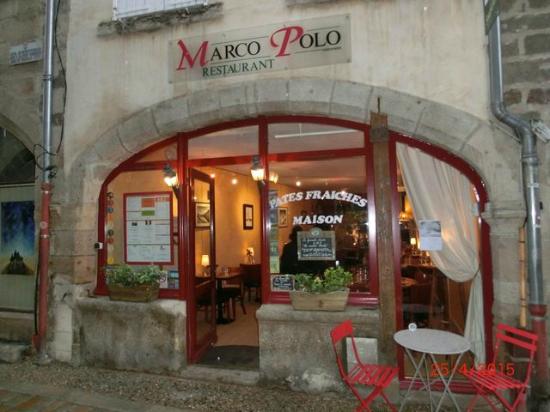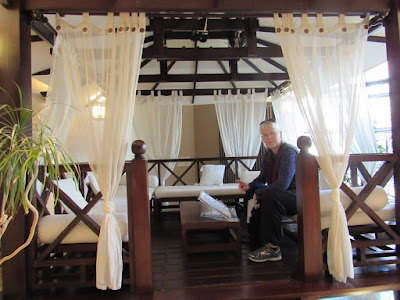
My friend, Tracy, came to Le Puy recently to spend a week with me. She is my first visitor from the USA. We spent our time together talking, eating, driving the French countryside, and just enjoying each other's company. Here we are picnicking in a public park on one of our drives.
Salami, cheese and fresh baguettes. What more could you want?

Here's a close-up of our shared dessert. Beautiful presentation.
 At Marco Polo, we had Italian pasta, the best-cooked pasta I've had in France so far besides mine. (They tend to over-cook the pasta and it falls apart.) Tracy had pesto, and I had an anchovy and olive sauce.
At Marco Polo, we had Italian pasta, the best-cooked pasta I've had in France so far besides mine. (They tend to over-cook the pasta and it falls apart.) Tracy had pesto, and I had an anchovy and olive sauce. One of the good things about the restaurants in LePuy is that they try to use local meats and produce. Most of the food raised is also organic and it definitely does NOT have genetically-modified products as GMOs are banned in Europe. The food is real, which is the main reason it is so tasty. Well, French cooking and its sauces help a lot, too!
At Le Chamarlenc, Tracy had boeuf bourguignon and I had veal in sauce. Delicious! This was one of our favorite restaurants--and Tracy's last night in Le Puy.
One day we just stayed at the International Centre and cooked a dejeuner of rice and mixed vegetables. Dîner included chicken, salad, and more vegetables. Sorry there are no photos. We were too busy cooking.
Lac Bouchet

We went to Lac Bouchet and trekked twice around the crater lake that was formed by an ancient volcano. We also had tea and cappuccino at the restaurant on the lake. A lovely afternoon on a beautiful day.



The restaurant at the lake has a full selection of meals, drinks, and ice cream. There's also a lodge for overnight stays where the air is fresh. A forest surrounds the lake.

A fisherman awaits a catch on the unpolluted, serene, glassy lake that is almost completely round.
The Cathedral of Le Puy

A view of Le Puy from the Cathedral. The city has 25,000 residents.
The Healing Stone. According to legend, a sick woman received the order to climb the mount of the Cathedral When she reached the top, she noticed a flat stone where she lay down and fell asleep. Around her gathered "a multitude of angels and saints..." When she awoke, she was healed. Today, pilgrims continue to confide their sufferings to the Virgin Mary by regularly laying the stone.
A beautiful, small, stone archway near the Cathedral. I can't resist taking photos of these medieval arches and stone streets. There's something intriguing about them.
The Cathedral cat that hangs around in a nearby neighborhood. He let me pet him once.
Vichy
 We went to Vichy, which is famous for its healing waters. We wanted to take a hot springs bath. We discovered, however, that the places to partake the healing waters were far more elaborate than we expected. You must make an appointment and then stay for treatments over a period of time, like a month. Instead, we found several fountains that provided water for free.
We went to Vichy, which is famous for its healing waters. We wanted to take a hot springs bath. We discovered, however, that the places to partake the healing waters were far more elaborate than we expected. You must make an appointment and then stay for treatments over a period of time, like a month. Instead, we found several fountains that provided water for free. At the fountains we brought back 6 bottles of Celestins water for Eluiza, who is still recovering from a fractured shoulder. You can either drink the water and/or apply it to your skin. Eluiza did both and reported that it relieved some of her pain! So our trip was purposeful even though it wasn't what we expected.
Vichy dates back to the time of Julius Caesar, who had a spa built there 2,000 years ago. Emperor Napoleon III (1808-73)--and his entourage of several thousand--made Vichy his primary summer resort. Many of the city's buildings were erected at this time and this also made the city unique for its elegance. From the 1880s to 1940s, Vichy was like a high-class Las Vegas with casinos, high-end restaurants and, of course, brothels. It is still a wealthy area.
According to Nathaniel Altman, author of The Ultimate Guide to Taking the Waters (2000), the Vichy spa hosts 12 springs, of which 6 are used for drinking. There are cold springs (Celestin, Parc and Lucas) and warm springs (Hôpital, Chomel and Grande Grille). There are also 2 well-equipped thermal establishments which feature mud baths and colonic irrigation as cures for rheumatism and liver problems. Altman describes the qualities of the Vichy water:
 "The source of Vichy Celestins, the most popular water used for drinking, emerges at 21ºC (71ºF) through strata of aragonite rock, formed by water-borne mineral deposits over millions of years. Layers of calcium carbonate have eroded over the centuries, contributing to Vichy's unique natural carbonation and mineralization. Vichy's low level of carbonation and high mineralization give it a taste that many associate with Alka-Seltzer. Vichy water has been used to treat stomach disorders, normalize biliary secretions, alleviate the symptoms of gastroesophagal reflux, provide relief from food and drug allergies, and reduce the symptoms of colitis." Nathaniel Altman
"The source of Vichy Celestins, the most popular water used for drinking, emerges at 21ºC (71ºF) through strata of aragonite rock, formed by water-borne mineral deposits over millions of years. Layers of calcium carbonate have eroded over the centuries, contributing to Vichy's unique natural carbonation and mineralization. Vichy's low level of carbonation and high mineralization give it a taste that many associate with Alka-Seltzer. Vichy water has been used to treat stomach disorders, normalize biliary secretions, alleviate the symptoms of gastroesophagal reflux, provide relief from food and drug allergies, and reduce the symptoms of colitis." Nathaniel Altman
The Thermes de Vichy uses modern hydrotherapy methods using the waters of Vichy.
Tracy checked out the lobby area of the Thermes de Vichy.

These volcanic-basalt tubs were used at the Thermes de Vichy in the 19th century for water treatments until 1902.

Vichy has a World War I memorial, which is quite a common site in France. The war's total number of military and civilian casualties was more than 41 million. There were over 18 million deaths and 23 million wounded, ranking it among the deadliest conflicts in human history. Many people, including the students at Oxford University in England, made a pledge to never wage war again. Unfortunately, after 100 years, that pledge still has never been realized.
During World War II, Pétain ordered the French Government's military leaders to sign an armistice with Germany on June 22, 1940. He also established an authoritarian regime that reversed many liberal policies like the independence of women and a free press. His government advocated central planning, tight government control over the economy, anti-Semitism, and anti-Bolshevism. His government was also regarded as a symbol of collaboration with the Nazis; it was suspended in late 1944 when the Allies liberated France. After the war, Pétain was tried and convicted of treason and sentenced to death. Because he was a war hero, he spent the rest of his life in prison until he died in 1951.

Opera House
Views of the beautiful central park of the city.
A white, wooden colonnade surrounds one of Vichy's smaller parks.
Beautiful buildings grace the downtown area. Here are just a few of them. I especially love triangular buildings set on a corner on Boulevard Russie.

 |
| Vive la France!! |





























































